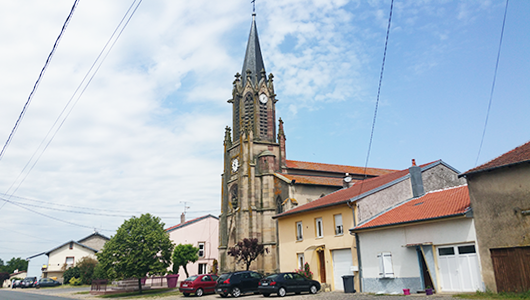Thiébauménil
Durée visite : 10 minutes
Moyen : Pédestre
Thibauménil dépendait en 1272 de l’abbaye de Belchamp. L’abbaye Notre-Dame de Belchamp se trouvait à Voujeaucourt, dans l’actuel Doubs. Elle appartenait à l’ordre des chanoines réguliers de Prémontré. Il est appelé couramment prémontrés, plus rarement norbertins. Il fut fondé par saint Norbert de Xanten au début du XIIe siècle. Le village a été dévasté lors de la guerre de Trente Ans. Le Duché de Lorraine, allié aux Habsbourg, fut envahi par les armées françaises et suédoises.
Thibaumenil depended in 1272 on the abbey of Belchamp. The abbey of Our Lady of Belchamp was located in Voujeaucourt, in present-day Doubs. It belonged to the order of the regular canons of Prémontré. It is commonly called pre-shown, more rarely norbertins. It was founded by Saint Norbert of Xanten in the early 12th century. The village was devastated during the Thirty Years’ War. The Duchy of Lorraine, allied with the Habsburgs, was invaded by the French and Swedish armies.
Thibaumenil war 1272 von der Abtei von Belchamp abhängig. Die Abtei Notre-Dame de Belchamp befand sich in Voujeaucourt, im heutigen Doubs. Sie gehörte zum Regulären Kanonenorden von Prémontré. Es wird gemeinhin vormontiert, seltener Norbertins. Er wurde anfang des 12. Jahrhunderts vom hl. Norbert de Xanten gegründet. Das Dorf wurde im Dreißigjährigen Krieg verwüstet. Das mit den Habsburgern verbündete Dothringen wurde von französischen und schwedischen Armeen überrannt.

D’or à la bande ondée d’azur chargé en chef d’une étoile d’or, et accompagnée en chef d’un chêne arraché de sinople, et en pointe d’une église de sable.
La bande ondée rappelle la Lorraine et le ruisseau qui traverse le village. L’étoile évoque l’abbaye de Belchamp qui possédait la localité. Le chêne évoque les forêts communales et l’église le village.
Gold to the wavy band of azure loaded in chief with a golden star, and accompanied in chief by an oak torn from sinople, and at the tip of a sand church.
The wavy strip recalls Lorraine and the creek that runs through the village. The star evokes the abbey of Belchamp which owned the town. The oak evokes the communal forests and the church the village.
Von Gold zu der spitzblauen Bande, die mit einem goldenen Stern beladen ist und von einer aus Sinopel gerissenen Eiche begleitet wird, und an der Spitze einer Sandkirche.
Die strömte Bande erinnert an Lothringen und den Bach, der das Dorf durchquert. Der Stern erinnert an die Abtei von Belchamp, der der Ort gehörte. Die Eiche erinnert an die Gemeindewälder und die Kirche das Dorf.

Les habitants de Thiébauménil s’appellent les Thiébauménilois et les Thiébauméniloises.
The inhabitants of Thiébaumenil are called the Thiébaumenians and the Thiéalsenlois.
Die Einwohner von Thiébaumenil heißen die Thiébaumenes und die Thiébaumeneoises.
Les points de visites
.
L’église Saint-Epvre est construite en 1853 sur les plans de Léon Vautrin, architecte diocésain. Elle est en néo-gothique flamboyant. La sculpture du tympan est de Pillement. Il représente la remise des clefs à Saint Pierre. Jésus lui remet deux clefs, une d’or et une d’argent, l’une pour le salut des âmes et l’autre du Paradis. Epvre fut évêque de Toul de 500 à 507. Très vénéré, il est le patron de 60 églises en Lorraine. Sa tête est conservée dans la basilique éponyme de Nancy.
The Church of Saint-Epvre was built in 1853 on the plans of Leon Vautrin, a diocesan architect. It is in flamboyant neo-Gothic. The sculpture of the eardrum is from Pillement. It represents the handing over of the keys to St. Peter. Jesus gives him two keys, one gold and one silver, one for the salvation of souls and the other of Paradise. Epvre was bishop of Toul from 500 to 507. Highly revered, he is the patron of 60 churches in Lorraine. Its head is kept in the eponymous basilica of Nancy.
Die Kirche Saint-Epvre wurde 1853 auf den Plänen des Diözesanarchitekten Léon Vautrin erbaut. Sie ist aus neo-gotischen Flammen. Die Trommelfell-Skulptur ist Pilling. Er stellt die Schlüsselübergabe an St. Peter dar. Jesus überreicht ihm zwei Schlüssel, einen goldenen und einen silbernen, einen zum Heil der Seelen und einen zum Paradies. Epvre war von 500 bis 507 Bischof von Toul. Er ist sehr verehrt und der Patron von 60 Kirchen in Lothringen. Sein Kopf ist in der gleichnamigen Basilika von Nancy erhalten.






